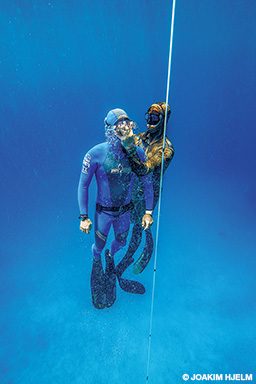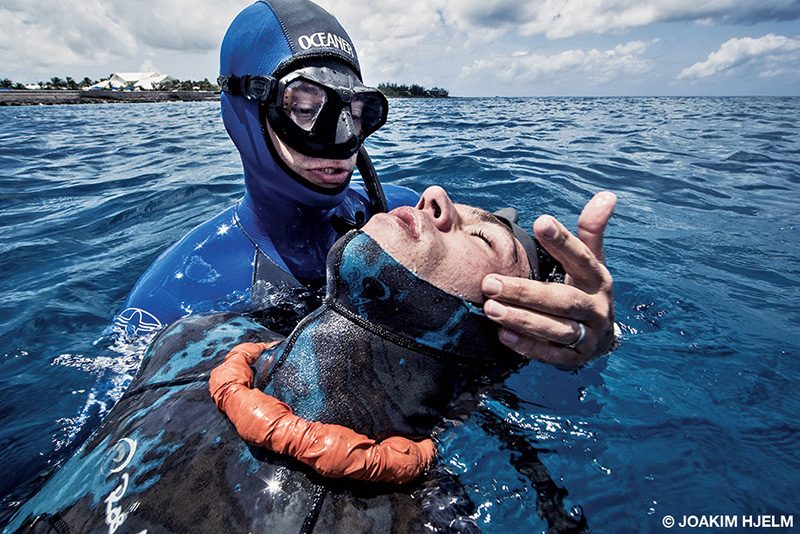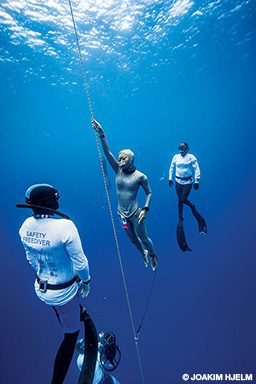Pushing yourself mentally and physically to overcome the challenges of a breath-hold dive can be a rewarding experience, but failing to make the appropriate safety considerations can have unfortunate consequences. If you prioritize personal safety, know your abilities, get proper training and dive only under direct supervision of other certified freedivers or safety divers, the odds are high that you’ll come out of the water ready to dive back in again.
Personal Safety
Unlike scuba diving, freediving doesn’t have a gatekeeper: Scuba divers can’t get an air fill or rent equipment without a certification card. Freediving, on the other hand, is open to anyone with access to a body of water. Humans have been freediving since someone looked into the water, saw something there that they wanted and went in after it. A significant number of freediving fatalities result from people diving without any formal training, so the challenge for freediving enthusiasts is how to encourage people to get training and reduce the number of injuries resulting from the sport.

People outside of the freediving community consider it to be a dangerous, extreme sport, but following proper safety protocols makes it quite safe. It is up to every member of the freediving community to recognize that diving alone or with an untrained buddy is unacceptable and to strongly encourage others to get proper training and dive safely.
I have been teaching freediving courses with Performance Freediving International (PFI) for more than five years, and one of the most common comments I hear from students is that they didn’t realize how dangerous freediving could be without a trained buddy or that having a lookout on the boat is not enough. Freedivers need to have eyes on each other on every dive and be close enough to intervene if needed. Proper training is key to recognizing a problem, being close enough to respond and knowing how to react and protect the airway of a freediver coming up from a dive.
A good buddy can retrieve you if you encounter a problem while freediving, but being overweighted could put you in a situation that even the most vigilant and highly trained buddy might be unable to manage. Students and untrained individuals often wear too much lead so that on the surface with a peak inhalation (their lungs completely full) they have to swim to keep their heads above the surface. If they were to lose consciousness after a prolonged breath hold, they would sink below the surface, possibly at an alarming rate.
Many students try to justify being overweighted because they want to get to the bottom more easily. While we all want to get down easily and have a relaxing dive, appropriate entry technique with correct weighting makes it even easier than loading up on lead. If you are properly weighted, you do not have to work as hard while diving. Therefore, you conserve necessary oxygen and are much more likely to return to the surface without issue.
Surfacing is the most critical part of a vertical freedive for the obvious reason of needing to breathe air at the surface but also because the partial pressure of oxygen in your cells decreases as you surface from a freedive. Oxygen is depleted as you metabolize it to fuel your muscles to move through the water; since you are holding your breath, you are not replacing the oxygen. The combined effects of you ascending and the pressure surrounding your body decreasing can cause you to lose consciousness. We call this a blackout, and 99 percent of blackouts happen either at the surface or within 16 feet of it. It is optimal to be weighted so that if a blackout occurs you will still end up at the surface. While blackouts seem daunting, freediving courses will teach you techniques to help you prevent blackouts. You will also learn how to respond to blackouts if they occur.

Learning Your Limits
Proper weighting and buddy contact go a long way to preserve your safety, but both safeguards could be ineffective if you exceed the limits of your experience and training. The techniques learned in a course will help you dive deeper and stay longer, but freediving limits are based on your personal abilities, so listen to your body and learn what you can handle.
Freediving in a controlled environment, such as in a class, is different from going with a buddy or two, unsupervised by a professional, with a camera or speargun in your hand. Out on your own you must dive even more conservatively. When diving in a group, never dive deeper than any of your buddies can, and don’t expose the group to conditions that any member is uncomfortable handling.
Proper Training
During the course, your instructor should provide a comfortable classroom that will facilitate learning and encourage questions. In confined water, you should be in a pool that is warm enough to comfortably learn in an appropriate wetsuit. For open-water training, your instructor should choose a site where everyone in the class can safely and comfortably enter, perform skills and exit. Instructors should cancel or reschedule sections if conditions are unsafe for the course level or for individual students who become seasick or get excessively cold.
Freediving instructors will encourage you to push yourself and perform outside of your comfort levels, but you should never feel pressured into doing something you do not want to do. If you choose not to perform a necessary skill, however, you will not get the certification.
In the end you will have a newfound respect for the water and the skills you need to freedive safely.

Competition Safety
Some divers who have the determination to train and the physical ability can freedive at a competitive level, where safety precautions are paramount. Competitive freedivers prioritize their personal safety by consulting their coaches and announcing only performances they can realistically attain in the higher-stress environment of a competition. It is common for athletes to train deeper than they plan to perform to remove some pressure of the competition.
The Association Internationale pour le Développement de l’Apnée (AIDA) and the Confédération Mondiale des Activités Subaquatiques (CMAS), the two leading organizations that oversee freediving competitions, have rules that competition organizers must follow. These rules ensure the safety of all athletes, safety divers, judges and spectators, and they keep the playing field even.

Some rules prohibit athletes from exceeding a maximum depth compared with their recent maximum depths, require use of a freediver recovery system or require athletes to return to the surface if they stop their descent. If someone breaks these rules or an incident occurs, teams of experienced and qualified safety divers are ready to make a rescue.
Safety divers (safeties), who have their own unique sets of rules that correspond to the rules for athletes, can be freedivers or scuba divers. PFI’s Deja Blue competition in Grand Cayman, one of the safest freediving competitions in the world, includes safety freedivers, deep scooter freediver safeties and deep scuba safeties to cover every zone of the athlete’s dive profile.
Most issues happen in the last one-third of the ascent, so freediver safeties go to one-third of the athlete’s announced performance depth and follow the athlete up from there. Other designated freediving safeties follow the athlete down on a scooter — at Deja Blue they go to depths of 196 feet (60 meters) to 230 feet (70 meters). Should freedivers have an issue while deeper than the upper third of their prescribed maximum depth on ascent, the scooter safety can protect their airway and quickly get them to the surface. To protect themselves from the effects of decompression illness (DCI) during these rapid ascents from depth, scooter safeties will offgas by breathing gas with elevated partial pressures of oxygen at the surface, a technical freediving technique developed by Kirk Krack, PFI’s founder and CEO.
Scuba safeties must not only have proper technical training and the experience to operate at these depths but also be well versed in freediving so they know what to look for and how to respond in a freediving emergency. They can use noisemakers to signal a problem and initiate the freediver recovery system or directly intervene by attaching a lift bag to the blacked-out or injured freediver, quickly sending him or her up the competition line to the surface.
The many facets of safety in freediving start with assuming personal responsibility. Never freedive alone, and always get training from a recognized agency to ensure your safety and the safety of the sport.
Explore More
Watch this video to learn more about safety divers.
© Alert Diver — Q2 2019